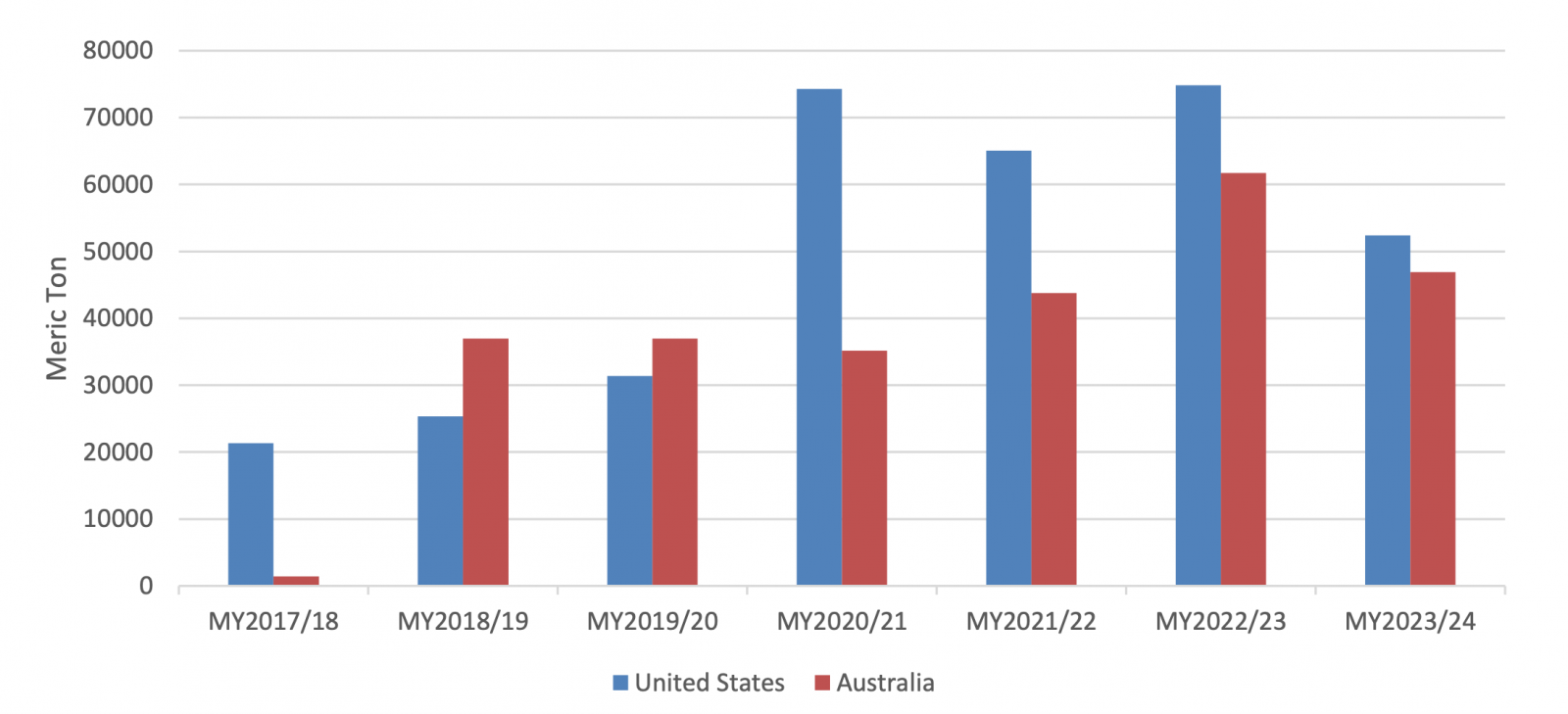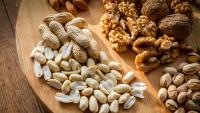You are here
Back to topChina’s Surging Nut Consumption: Per-Capita Intake Set To Double by 2030

According to the most recent China: Tree Nuts Annual report from the U.S. Department of Agriculture’s Foreign Agricultural Service, China’s tree nut consumption has grown by 5% annually over the last five years, with the per-capita consumption forecast to reach 1 kilogram in 2030, almost double that in 2023. Last year, China’s nut imports totaled 427,000 metric tons, making the country the world’s largest importer of macadamia nuts, second-largest importer of pistachios and third-largest importer of almonds. Increased global supply, shifting dietary preferences and product innovation in the nut sector are all expected to contribute to a continued rise in China’s nut imports.
Consumption
Although overall nut consumption in China is relatively low, changes in dietary patterns are anticipated to boost the country’s nut intake in the near future. Given that consumers in the post-pandemic era are increasingly concerned about food nutrition and function, tree nuts, which represent a healthy snack option, have recently become immensely popular among middle-class urban dwellers.
According to data from the International Nut and Dried Fruit Council, China’s tree nut consumption has grown by 5% annually over the past five years, with the national yearly intake of 8 million metric tons (kernel equivalent) representing 15% of the global total. The INC figures indicate that the country’s per-capita tree nut consumption in 2023 was 0.56 kilograms, which is approximately one-fifth of the 2.6 kilograms consumed in the United States and about half the 0.98 kilograms consumed in South Korea. Given China’s potential for growth, the INC estimates that the per-capita tree nut consumption may reach 1 kilogram in 2030, almost double that in 2023.
Market research data collected during this year’s Spring Festival holiday show that tree nut gift boxes (selected by 46.3% of respondents) overtook gift boxes of tea (36.4%) and baijiu (a Chinese liquor, 34.4%) as the most popular gift box category.
In China, tree nuts are primarily consumed by middle- and upper-class individuals residing in first-tier cities and coastal regions of eastern China. Moreover, 62% of consumers are women, while 53% are aged 34 and under, corresponding to the so-called Generation Z. This generation is known for their commitment to a healthy lifestyle and personal happiness. According to data from a private research agency, 50% of Chinese consumers buy tree nuts at least once a week, spending more than 100 Chinese yuan ($13.86) per purchase.
As the nut sector continues to develop new methods of using nuts, industry insiders are optimistic about the rise in nut consumption in China. Currently, China’s tree nut market is dominated by snack products, with the share of foods made from processed nuts being modest. Nut butters, nut oils, nut powders and nut beverages are some of the ways that processed nuts can be integrated into the Chinese diet. The culinary uses of nuts have been constantly expanding around the globe in recent years. For example, macadamia nuts can be added to liquid products to boost concentration and flavor or used as a plant base for non-dairy beverages.
It is worth noting that plant-based diets are becoming increasingly popular in China, which opens up numerous market opportunities for nuts. China’s plant-based food business has expanded at a 14% annual rate over the last five years, with its value reaching $13 billion in 2023. Furthermore, the number of enterprises producing plant-based foods and beverages has now topped 8,000.
Trade
According to a tree nut trade and consumption report published in May 2024 by the China Academy of International Trade and Economic Cooperation under the Ministry of Commerce, China’s imports and exports of tree nuts have been on the rise since 2015. The report shows that the country’s nut imports surged from 117,000 metric tons in 2015 to 427,000 metric tons in 2023, while exports rose from 63,000 metric tons to 299,000 metric tons. China has long been a net importer of tree nuts, with this trend likely to continue owing to the expansion of its food processing industry and the difficulty of domestically cultivating popular foreign types of nuts such as pecans.
Imports
According to INC data, China’s in-shell and shelled nut imports hit a five-year high in 2023. Recent economic woes, however, have made Chinese consumers more price sensitive, which has in turn prompted food producers to reduce their expenses in an effort to remain competitive. As a result, importers have become more conscious of cost when sourcing nuts from overseas suppliers.
China by far tops the global ranking in terms of macadamia nut imports, with total purchases of both in-shell and shelled products doubling over the last three years. This surge is largely attributable to an increase in the worldwide supply and a subsequent decline in market prices. Traders predict that the rapid increase in global macadamia nut imports will slow down in 2024/25 on account of the robust demand from China, Europe and the United States, which will cause prices to rise. With its rapidly increasing output, South Africa has emerged as China’s primary macadamia nut supplier, accounting for approximately half of the market share, followed by Australia and Kenya.
At the same time, China was the world’s second-largest purchaser of pistachios in 2023, trailing only the European Union. The majority of the country’s pistachio supply originates from the United States, which accounts for over 80% of China’s overall pistachio imports. Last year also saw a 140% increase in imports from the United States owing to record production in California and a limited supply from Iran. In 2024/25, China’s demand for pistachios is expected to remain high, although imports from the United States will likely decline compared with 2023/24. Imports from Iran, China’s second-largest pistachio supplier, are projected to increase as supplies recover. In regard to Turkey, the world’s second-biggest producer of pistachios, the country is not a major supplier to China. Nonetheless, considering that Turkey’s production is expected to double this year, China may increase its imports.
.png)
With respect to almonds, China’s imports ranked third globally in 2023, after the European Union and India. Given that almond imports are known to be price sensitive, China’s imports are predicted to pick up in 2024/25 as all major producing countries, particularly the United States, are on track to witness bumper harvests. In 2023/24, China’s almond imports dropped by roughly one-third as production in California and Australia reached their lowest levels in five years, leading to a supply shortage. The United States continues to be China’s primary almond supplier, although Australian almonds are quickly gaining market share owing to the bilateral free trade agreement between the two countries. China has also started to import almonds from Spain, although the quantity has so far remained relatively small.

Exports
Aided by growing domestic production, China’s exports of in-shell and shelled walnuts continue to rise, with this upward trend expected to persist during the 2024/25 season. Chinese walnuts are available in various Middle Eastern and Central Asian countries, particularly the United Arab Emirates and Kyrgyzstan.
A similar boost in local production has led to shelled Chinese macadamia nuts being introduced to international markets. At present, the main destinations are Australia and the United States, whose import volumes have been stable. In-shell and shelled Chinese almonds, on the other hand, are primarily sent to neighboring countries such as Vietnam. Volumes have been modest thus far, but they are gradually increasing.
Images: Pixabay (main image), U.S. Department of Agriculture (body images)
This article was based on a Chinese article. Read the original article.















Add new comment